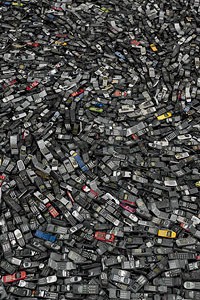
This Earth Day, Make Cellphone Recycling Second Nature
The EPA estimates that there are 141 million mobile devices at end-of-life, but only 11.7 of those will be recycled.
- By Steve Skurnac
- Apr 20, 2013
Early cellphones allowed users to do two things: make calls and receive calls. Today, cellphones are multifunctional and essential to the way we live life: they keep us connected, entertained, informed, and organized.
But for all cellphones do for us, the relationship isn’t a long-term one and typically lasts only 24 months based on research from Recon Analytics. That’s one reason why 141 million mobile devices were ready for end-of-life management, according to the most recent figures from the U.S. EPA.
The problem is only 11.7 million—a paltry eight percent—of those mobile devices were collected for recycling, reports the U.S. EPA. Data security concerns and a lack of awareness about the available options likely contribute to this low recycling rate. When a new product launch turns a previously state-of-the-art cellphone into a paperweight, here’s how to recycle the old one.
Small device, big impact
As with other electronic devices, mobile phones rely on precious metals, copper, glass, plastic, and other materials to deliver the performance users expect. Extracting and processing these materials to manufacture cellphone components is energy-intensive and contributes to air and water pollution.
But recycling recovers these materials so they can be used in new products. The U.S. EPA estimates that recycling 1 million mobile phones reclaims 35,274 pounds of copper, 772 pounds of silver, 75 pounds of gold, and 33 pounds of palladium.
Unused, but not useless
Unwanted, but still working, devices and accessories can be traded in for cash or donated. Old cellphones can also be dropped off at a retailer, such as Best Buy, Office Depot, or Staples, or at a community electronics collection event for recycling, regardless of age or model.
Another option is to return the device to the cellphone manufacturer, service provider, or retailer. To participate in one of these take-back programs, visit the company’s website to learn more about their recycling services.
After phones are dropped off or mailed back, they are usually shipped to a recycling facility for inspection. Working devices will be refurbished and returned to service. Cellphones broken beyond repair will be taken apart and the reusable materials recovered and recycled.
Your phone, your identity
Mobile phones allow instant and unlimited access to personal and business information. A recent Pew Research Center’s Internet & American Life Project survey revealed that:
- 80 percent of adult cellphone users send or receive text messages on their phones
- 50 percent send or receive emails
- 31 percent look for health or medical information online
- 29 percent check bank account balances or engage in online banking
This data—contact lists, emails, texts, as well as bank account and credit card information—can lead to an increased risk of identity theft and consumer fraud if left intact on a discarded device.
To reduce this risk, follow these steps prior to parting with your phone.
- Backup the data you want to keep
- Contact your wireless carrier to terminate your service
- Delete stored information from the phone by following device-specific instructions
- Remove the SIM card and shred it
For more information, contact your service provider or cellphone manufacturer. When cellphones are sent to certified electronics recyclers, such as Sims Recycling Solutions, special care is taken to ensure all data is destroyed.
About the Author
Steve Skurnac is the president of Sims Recycling Solutions, a global provider of electronics reuse and recycling services.